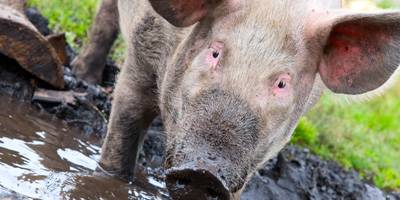Sweating like a pig: busting the myth
Ever heard the expression: sweating like a pig? It’s sure to be used a lot these days in these parts of Europe as temperatures are through the roof! Well this expression is quite misleading as pigs don’t really sweat. They do have some sweat glands but far less than us humans and the ones they do have are not functional – they do not respond to thermoregulatory cues.
Very few animals sweat to relieve heat. In fact pretty much only humans, primates and horses use perspiration to keep body temperature down the way we do. Swine, like their genetical cousin the hippopotamus (yes, that’s right), prefer to dip in water or mud to keep their temperature down as much as possible. The water in the mud evaporates from their skin and carries away heat in the same way that sweat does for us. This behavior is the reason for the idyllic image we have in our minds of swine in a pool of mud. They are large animals that tend to get hot fairly quickly.
Swine and heat stress
The inability to sweat as a cue to heat, makes swine especially vulnerable to heat stress. That’s why swine farmers do what they can to keep them comfortable. More about what can be done to keep swine cool and production up in this article>>
One way we can help swine to cope with heat stress is through the optimization of the dietary Electrolyte Balance of the feed with ProPhorce™ AC 299. Read more about ProPhorce™ AC 299 here >>
So where DOES the expression come from?
Sweating like a pig is an old expression. The ‘pig’ in ‘sweating like a pig’ is most likely short for ‘pig iron’. Pig iron is a an intermediate product of the iron industry, also known as crude iron. To mold iron it needs to be heated to extreme temperatures in order to liquify it. So how do you know the metal is cool enough to transport? When the pig iron ‘sweats’. As the metal cools, droplets of moisture from the surrounding air form on the surface.
